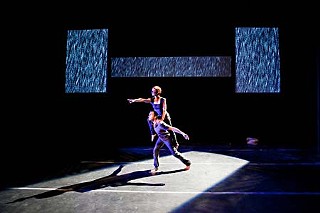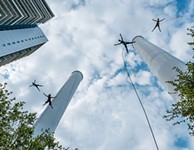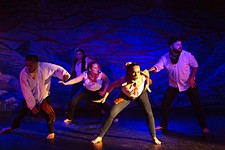Exhibitionism: The Geometry of Proximity
This dance exploring reinvention and rejuvenation was hobbled by choreography that didn't feel new
Reviewed by Jonelle Seitz, Fri., Oct. 5, 2012
The Geometry of Proximity
Rollins Studio Theatre at the Long Center, 701 W. RiversideSept. 29
It's both impressive and endearing that Andrea Ariel, a successful film, television, and theatre choreographer, and Steve Ochoa, a retired Broadway performer, still regularly take the stage, in their 50s and 40s, respectively. Dance is largely a celebration of youth, but when more mature dancers perform, their life experiences, depth, and concerns (coupled with the relentlessly poignant has-been of the aging body) can result in welcome nuance, layering, and sophistication. But despite the sophistication of the lighting, sound, and video, Ariel's choreography in The Geometry of Proximity lacked innovation and depth, which undermined the theme of transformation and rejuvenation.
Ariel and Ochoa, claiming opposite halves of the stage for most of the 50-minute piece, moved, in an overabundance of attitude turns and spiraling arms, through stages of self-analysis and discovery, exploration and identity, and finally, to cleansing or rebirth. Their parallel journeys occasionally collided in a partnering sequence, but the characteristics of the relationship weren't clear. Why did one of them usually begin a sequence a moment after the other? What was the basis for their mimed argument? Only occasional freshness, such as the quirky boxer-like poses that followed that argument, aligned the movement with Colin Lowry's three-screen video design, Graham Reynolds' workable and catchy score, and Jason Amato's crayon-box, jewel-rich lighting.
Near the end, after Ariel and Ochoa had showered in rain and baptized themselves in separate basins (the water evoked by a combination of lighting, sound, and video), they faced the audience, palms open, in Amato's bright white beams. In starkly lit serenity, the performers remained there for a time, and I saw the depth and honesty in the sinews, the veins, and the wrinkles. While choreography, in general, is a compulsive liar, the body tells the truth.
The ending seemed to ask whether a person really can transform. Ariel and Ochoa left their open-palmed posts and furiously spiraled into blackness amid a jarring crescendo. The furiousness, perhaps, mirrored the frustration that comes with striving for the impossible – to change our lot, to cleanse, to reinvent. We can never be new again, or go back, and these dancers' struggle to do so was a solitary experience fraught with dissatisfaction. In my mind, the work became juxtaposed with Ellen Bartel's "Somebody Else" (from the 2011 Big Range Austin Dance Festival), in which the performers dealt with unsavory (unspecified but wholly wrought) situations by acknowledging their stuck-ness and need to both give and receive support. While Bartel's theme was close to universal, The Geometry of Proximity, with its focus on egoist reinvention, suggested a more first-world problem.











